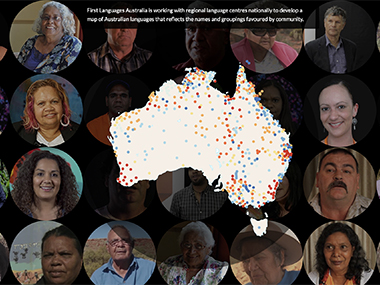The Gambay Language Map

The website image of many language groups coming together in harmony
Jeremy Eccles | 19.06.20
Author: Jeremy Eccles
News source: Press Release
Ever wanted to speak just a little of the language of the artists who created your artworks? Or even just to find out what language or languages they do actually communicate in?
Well, First Languages Australia has now developed an interactive map to display and promote the diversity of Australia’s Aboriginal languages and Torres Strait Islander languages. The map is called Gambay, which means ‘together’ in the Butchulla language of the Harvey Bay region in Queensland. The data included on this map has been contributed by regional language centres and programs working directly with language communities all across this country.
Gambay, amazingly, showcases over 780 languages. It is the first Australian map that allows Aboriginal and Torres Strait Islander communities control over the way their languages are publicly represented.
To support language revival and maintenance at the community level, the map can group languages by shading to help communities identify the neighbouring languages with which they may most easily share language resources. As only around twenty of Australia’s traditional languages are used daily by fluent speakers, establishing links between related languages is key to reviving Australia’s first languages.
Teachers’ notes have been developed to assist school teachers to teach about Indigenous languages across key subjects including; English, Maths, Science, History, Geography and Civics. The notes are linked to the Australian national curriculum and cover each year level from foundation to Year 10, in line with the Aboriginal and Torres Strait Islanders Histories and Cultures Cross-curriculum priority.
To encourage better understanding of the importance of Australia’s first languages, video clips of ‘Language Legends’ are being collected and published on the map. A ‘person’ icon on a map dot represents a Language Legend clip. The clips allow Australian language workers to personally explain the importance of their language/s and demonstrate their passion and dedication to their revival or maintenance.
The videos are moving expressions of the diversity of Australia’s languages, their present endangerment status, and aspirations. They provide an opportunity for members of the Australian public to meet language workers from their own regions and gain an insight into the language activities they are involved in, as a bridge to cross cultural understanding.
From a technical perspective, First Languages Australia is grateful for the collaboration of the Queensland Indigenous Languages Advisory Committee in sharing the tools developed for Nyurrangu Ngardji, the interactive language map of the state of Queensland.
“What I love the most is that the map is interactive. It allows our language warriors to tell their story on their country”, says Melinda Holden. “Language is important because it is an identity and a belonging to a group. You’ve got to know who you are and where you are from. I think language is part of that”, adds Wendy Ranger.
A little research into my Sydney languages suggests that the Eora Nation is still recognised as covering the Basin from the Hawkesbury to the Georges River, as mapped originally by Norman Tindale, confirmed by AIATSIS in 1994. But the interactive map reveals quite a linguistic overlap with the Dharug; indeed Richard Green, the enthusiastic Dharug speaker who can be heard when you click on his language group, claims Cammeraygal as a Dharug word, though it's clearly in the Eora territory of the Lower North Shore (which Tindale subdivides into Borogegal on Bradleys Head and Walumedegal at Milsons Point). The Gadigal – of whom we hear so much in Sydney's Welcomes to Country – don't actually make it on to either the new interactive map or the AIATSIS version. Only Tindale places their 'horde' “on the south side of Port Jackson”.
Fascinating stuff. And accompanied by singing of 'The Body Song' in 'Cammeraygal' by the kindy kids at Willoughby Public School. Surely it should be in Eora?
Share this:
»  del.icio.us
»
del.icio.us
»  Digg it
»
Digg it
»  reddit
»
reddit
»  Google
»
Google
»  StumbleUpon
»
StumbleUpon
»  Technorati
»
Technorati
»  Facebook
Facebook
Contact Details
Further Research
News Archive
- 02.07.20 | Yiribana
- 26.06.20 | Fashion Goes Indigenous
- 25.06.20 | Desecration in the East Kimberley
- 19.06.20 | The Gambay Language Map
- 09.06.20 | ARTISTS HONOURED
- 09.06.20 | ONLINE SYDNEY FILM FESTIVAL
- 03.06.20 | “An Archive of the Industry”
- 02.06.20 | RIP Malu Gurruwiwi – Custodian of the Banumbirr
- 31.05.20 | The Beach
- 27.05.20 | First Nations Arts Awards
- 21.05.20 | Media Muddles Aboriginal Politics
- 20.05.20 | The War in Mparntwe
- 18.05.20 | COOKED 2
- 14.05.20 | 'Truganini – Journey Through the Apocalypse'
- 11.05.20 | BIDYADANGA CLOSE-UP
Advertising

